 Pareltjes II Bekende en onbekende schilderijen uit de tweede helft van de vorige eeuw 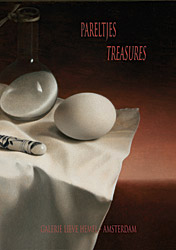
Een beetje trots, wat weemoed, een snuifje berusting, dat is wat ik voel terwijl ik deze catalogus voorbereid. Een deel van het verleden herleeft, ik mag zomaar een cyclus mag ervaren. Met één been sta ik in het verleden, met het andere in het heden. Het verschil tussen mijn functioneren als galeriehouder, die bouwt aan de reputatie van een kunstenaar, en als kunsthandelaar, die te maken heeft met gevestigde reputaties, vervaagt. Gedeeltelijk ligt het nog anders. Het wordt me gegund om sommige kunstenaars, die te vroeg zijn overleden om in bredere kring bekendheid te hebben verworven, nogmaals onder de aandacht te brengen. Want één ding staat vast, René Miković, Herman van Rossum, Karel Wiggers en in het bijzonder Hendrick Brandtsoen zijn stuk voor stuk – bescheiden uitgedrukt – bovengemiddeld getalenteerde kunstenaars. Er is nog een ander verschil. Van een levende kunstenaar is nog ongewis wat hij of zij in de toekomst aan zijn of haar oeuvre gaat toevoegen, van de overledenen is het oeuvre bekend en we zijn al blij als er zo nu dan nog iets beschikbaar komt, maar nieuwe werken zullen het niet meer, nooit meer zijn. De verrassing is eventueel die van “hoe heb ik dit kunnen missen”, een zelfverwijt hoogstens… Maar ach, hoe kan ik ook denken dat het leven ordelijk verloopt. Van deze gelegenheid maak ik graag gebruik om mij te richten tot de vele trouwe relaties waarmee ik in de loop van bijna 43 jaar contact heb gehad en dikwijls nog heb. Ik ben namelijk ook een beetje nieuwsgierig of er onder u zijn die schilderijen uit deze kleine collectie herkennen, misschien zelfs wel tot aanschaf bereid waren, maar een ander de eer en het plezier moesten gunnen. Het blijkt maar weer, soms zorgt het leven voor herkansing. Top Little Treasures II Known and unknown paintings from the second half of the twentieth century 
A touch of pride, a taste of melancholy, a trace of resignation: it is with these feelings that I have been working on this catalogue. Part of the past has been rekindled and I have been given a unique opportunity of experiencing an entire cycle: one foot in the past, the other in the present. The boundary line between my role as a gallery owner, who helps build artists’ reputations, and that of an art dealer, who has to make allowances for established reputations, has started to blur. And then there is another dimension to all of this, in that it has enabled me to redirect attention to a number of artists whose early deaths have forever stopped them carving out a reputation for themselves among a wider audience. There cannot, after all, be any doubt as to the above-average artistic talents – to say the least – with which René Miković, Herman van Rossum, Karel Wiggers and, most particularly, Hendrick Brandtsoen were each blessed. There is yet another difference. You never know with living artists what they are yet to add to their body of work, whereas deceased artists have by necessity rounded off theirs. The best we can hope for is for works by a deceased artist to resurface every now and again, but these will invariably be existing rather than new works, possibly bringing with them an element of surprise (“how could I not have noticed this before?”) or even a hint of self-reproach … Then again, hoe naïve am I in expecting life to take an orderly course. I am delighted to be given the opportunity of addressing the many loyal clients and acquaintances with whom I have had dealings (and more often than not continue to date to have dealings) over what has been just under 43 years, as I cannot help wondering whether there are those among you who recognise the paintings making up this small collection. Some of you may at the time even have considered making a purchase yourselves even though you eventually made way for someone else to enjoy the glory and the pleasure. Trust life to have a way of offering another chance when you least expect it ... |

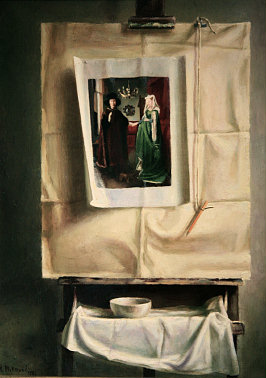 René Miković (1954-1996) was born in Zagreb and as an art student wandered from one European country to the next, attending art colleges here and there to glean all those elements that ended up making him a painter who defied classification in terms of national characteristics, and finally taking root in the northern province of Groningen. The small painting shown here was one of the first works he created there. His penchant for trompe-l’oeil – which in this early painting he stopped short of maxing out on – went on to become a regular feature of his work, propping up the literary themes that dominated many of his paintings. 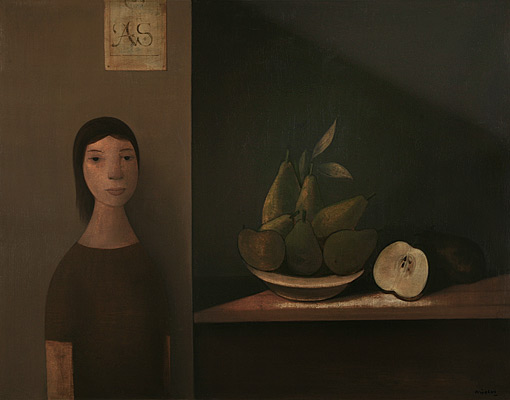 Karel Wiggers (1916-1989) is best known for his unadorned, seemingly naively painted portraits of women and girls. However, what may at first glance come across as technical simplicity is too sophisticated to allow his work being characterised as naïve: words such as “simplification” and “abstraction” approximate the essence more closely. More naïve, yet with a difference is the way in which the protagonists virtually always face their audience head-on. However, the wonder and resignation in the faces of the portrayed could be the outcome of a spiritual process that likewise defies being described as naïve. As unambiguous as the facial expression of the models may be, the secret of the artist’s effortlessness defies straightforward clarification. 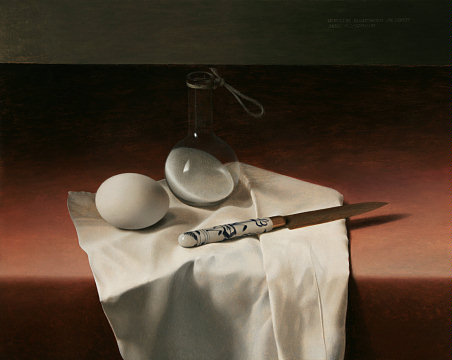 Flemish-born Hendrick Brandtsoen (1938-2003) was a scholarly critic of the social structure as well as someone whose contrariness was at odds with standards generally adhered to in artistic circles. Innovation was something he never cared for, it being the seventeenth century masters he sought to rival. Nevertheless traces of today’s world unwittingly crept into his originally highly classical still lifes, which always remained classical, yet in a twentieth century kind of way. Owing in part to his oeuvre being quite small, Brandtsoen’s reputation has always remained confined to a select circle of connoisseurs, even though the partnership with the New York-based Alexander Milliken Gallery (from 1985 to 1990) quickly earned him the status of an exceptional talent and caused his work in a matter of years to command prices of up to five times of what they had been previously. Unfortunately his poor health put the kybosh on his career not much later. 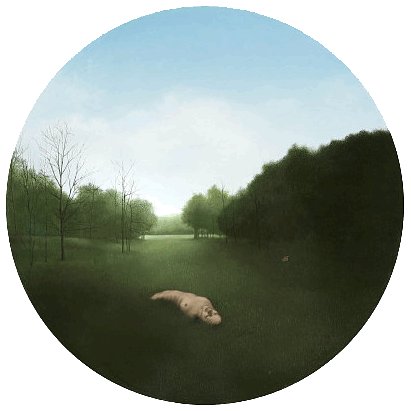 Herman van Rossum (1952-1991) was a disciple of what could be characterised as the “Utrecht School”, which despite its strong realistic orientation constitutes more of a breeding ground than a movement and which is associated with names such as Moesman, Peter Vos and Peter van Poppel. Van Rossum in his brief lifetime developed from a surrealist to what I like to describe as “the painter of the stillest mist in the Netherlands”, which makes it all the more curious that the surreal was always putting in an appearance in the artist’s subtle interplay between green and infinite white. Authoritative as the Ophelia theme (which of course for centuries has captivated painters), once noticed, comes across as, it nevertheless represents an almost intermittent aspect of his work. Was it nostalgia, was it covert suffering that pushed the ever-cheerful Van Rossum? |
Top